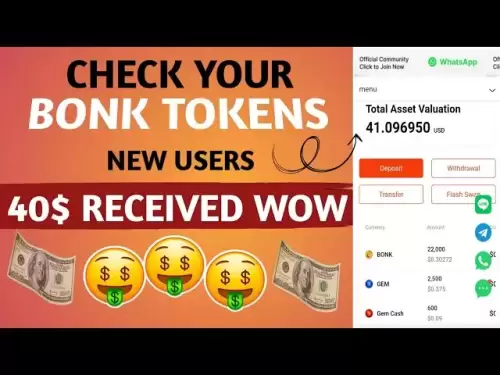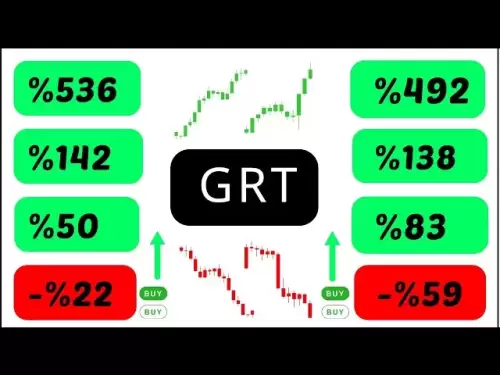-
 Bitcoin
Bitcoin $107,467.9126
1.26% -
 Ethereum
Ethereum $2,447.5288
-0.12% -
 Tether USDt
Tether USDt $1.0005
0.00% -
 XRP
XRP $2.1921
0.13% -
 BNB
BNB $647.2897
0.50% -
 Solana
Solana $144.8627
-0.37% -
 USDC
USDC $0.9996
-0.03% -
 TRON
TRON $0.2732
0.10% -
 Dogecoin
Dogecoin $0.1652
-0.18% -
 Cardano
Cardano $0.5700
-2.87% -
 Hyperliquid
Hyperliquid $37.0274
-1.81% -
 Bitcoin Cash
Bitcoin Cash $484.6957
0.19% -
 Sui
Sui $2.7354
-2.19% -
 Chainlink
Chainlink $13.1727
-1.49% -
 UNUS SED LEO
UNUS SED LEO $8.9978
-0.04% -
 Stellar
Stellar $0.2421
-2.33% -
 Avalanche
Avalanche $17.5633
-3.51% -
 Toncoin
Toncoin $2.8476
-1.94% -
 Shiba Inu
Shiba Inu $0.0...01166
-0.56% -
 Litecoin
Litecoin $85.1071
0.09% -
 Hedera
Hedera $0.1502
-2.96% -
 Monero
Monero $310.2774
-1.64% -
 Dai
Dai $0.9999
-0.01% -
 Polkadot
Polkadot $3.3584
-1.88% -
 Ethena USDe
Ethena USDe $1.0003
-0.04% -
 Bitget Token
Bitget Token $4.4443
2.90% -
 Pi
Pi $0.6242
14.04% -
 Uniswap
Uniswap $6.9774
-2.86% -
 Pepe
Pepe $0.0...09535
-5.05% -
 Aave
Aave $256.7574
-3.35%
Why is the transfer of INJ wallet delayed How to check the transaction status
INJ wallet transfers can be delayed due to network congestion, low fees, or technical issues; check status using transaction ID on blockchain explorers like Injective Scan.
May 06, 2025 at 09:07 am

The transfer of INJ (Injective Protocol) wallet can be delayed due to various reasons, and understanding these can help you better navigate the cryptocurrency ecosystem. In this article, we will explore the common causes of delayed INJ wallet transfers and provide a detailed guide on how to check the transaction status.
Common Reasons for Delayed INJ Wallet Transfers
Network Congestion: One of the most frequent causes of delayed transactions is network congestion. When the blockchain network is overwhelmed with a high volume of transactions, it can lead to slower processing times. This is particularly common during periods of high market activity or when there are significant events in the crypto space.
Low Transaction Fees: Another reason for delays can be low transaction fees. If the fee you set for your transaction is too low, miners or validators may prioritize other transactions with higher fees, causing your transaction to be processed later.
Technical Issues: Technical issues on the blockchain or with the wallet service itself can also cause delays. This could include server downtimes, software bugs, or maintenance activities.
Pending Confirmations: Some transactions may be stuck in a pending confirmation state. This happens when the transaction is broadcasted to the network but has not yet been included in a block. The number of confirmations required can vary, and until the transaction is confirmed, it may appear as delayed.
How to Check the INJ Transaction Status
To check the status of your INJ transaction, follow these detailed steps:
Find Your Transaction ID: First, you need to locate your transaction ID or hash. This can usually be found in the transaction history section of your wallet. Copy this ID as you will need it to track your transaction.
Use a Blockchain Explorer: Navigate to a blockchain explorer that supports INJ transactions, such as Injective Scan or Etherscan if your INJ is on the Ethereum network. Paste your transaction ID into the search bar.
Analyze the Transaction Details: Once you have entered your transaction ID, the blockchain explorer will display detailed information about your transaction. Look for the following key points:
- Status: This will indicate whether the transaction is pending, confirmed, or failed.
- Confirmations: Check how many confirmations the transaction has received. More confirmations generally mean a more secure and finalized transaction.
- Block Height: This shows the block number in which your transaction is expected to be included. If it is still in the mempool (a queue of unconfirmed transactions), it will not have a block height yet.
Monitor the Transaction: Keep an eye on the transaction status by refreshing the page periodically. If the transaction remains in a pending state for an extended period, it might be due to one of the reasons mentioned earlier.
Steps to Resolve a Delayed INJ Transaction
If your INJ transaction is delayed, consider the following actions:
Increase the Transaction Fee: If your transaction is stuck due to a low fee, you can try to increase the fee by using a feature called transaction acceleration or child pays for parent (CPFP). This involves creating a new transaction that references the original one and pays a higher fee.
Contact Wallet Support: If the delay persists, reach out to the wallet support team. Provide them with your transaction ID and any error messages you have encountered. They may be able to assist in resolving the issue or provide further insight into the cause of the delay.
Wait for Network Conditions to Improve: Sometimes, the best course of action is to wait patiently. Network congestion can clear up over time, allowing your transaction to be processed.
Understanding the Role of Gas in INJ Transactions
Gas plays a crucial role in the execution of transactions on the blockchain. In the context of INJ, which operates on the Ethereum network, understanding gas can help you better manage your transactions.
What is Gas?: Gas is the unit of measurement for the computational effort required to execute operations on the Ethereum network. Each operation has a set gas cost, and the total gas used by a transaction determines its fee.
Setting Gas Prices: When you initiate an INJ transaction, you can set a gas price, which is the amount you are willing to pay per unit of gas. A higher gas price can incentivize miners to prioritize your transaction, potentially reducing delays.
Gas Limit: The gas limit is the maximum amount of gas you are willing to use for your transaction. If the transaction requires more gas than the limit, it will fail. Setting an appropriate gas limit is crucial to ensure your transaction can be processed successfully.
Tips to Avoid Future INJ Transaction Delays
To minimize the risk of future delays, consider these strategies:
Monitor Network Conditions: Before initiating a transaction, check the current network conditions. Tools like Etherscan provide real-time data on network congestion and average transaction times.
Set Appropriate Fees: Use gas price estimators to set an appropriate fee for your transaction. Websites like EthGasStation can help you determine the optimal gas price based on current network conditions.
Use Reliable Wallets: Choose a reputable and reliable wallet that has a good track record of handling transactions efficiently. Regularly update your wallet software to ensure you have the latest features and security enhancements.
Plan Your Transactions: If possible, plan your transactions during less busy times on the network. Avoid initiating transactions during peak hours or when significant market events are expected.
Frequently Asked Questions
Q: Can I cancel a delayed INJ transaction?
A: Canceling a delayed INJ transaction can be challenging once it has been broadcasted to the network. If the transaction is still in the mempool, you might be able to replace it with a new transaction that has a higher fee using the Replace-By-Fee (RBF) feature, if supported by your wallet. However, if the transaction has already been included in a block, it cannot be canceled.
Q: How long should I wait for an INJ transaction to be confirmed?
A: The confirmation time for an INJ transaction can vary based on network conditions. Under normal circumstances, you might expect a transaction to be confirmed within a few minutes to an hour. However, during periods of high congestion, it could take longer. It's advisable to wait at least 24 hours before taking further action.
Q: What should I do if my INJ transaction is stuck due to a high volume of transactions on the network?
A: If your INJ transaction is stuck due to high network volume, consider increasing the transaction fee to incentivize miners to process it faster. If this is not possible, you may need to wait for the network congestion to subside. Monitoring network conditions using tools like Etherscan can help you understand when the congestion might clear.
Q: Is there a way to speed up an INJ transaction if it's taking too long?
A: Yes, you can attempt to speed up an INJ transaction by increasing the transaction fee. Some wallets support features like transaction acceleration or child pays for parent (CPFP), which allow you to create a new transaction that references the original one and pays a higher fee. This can encourage miners to process the original transaction more quickly.
Disclaimer:info@kdj.com
The information provided is not trading advice. kdj.com does not assume any responsibility for any investments made based on the information provided in this article. Cryptocurrencies are highly volatile and it is highly recommended that you invest with caution after thorough research!
If you believe that the content used on this website infringes your copyright, please contact us immediately (info@kdj.com) and we will delete it promptly.
- Pi Coin Price Prediction: June 26 - Will It Break $0.70?
- 2025-06-26 09:05:13
- Tokenization Takes Flight: Cross-Border Transactions Soar to New Heights
- 2025-06-26 08:30:12
- Midnight Airdrop: NIGHT Tokens and the Cardano-XRP Connection
- 2025-06-26 08:50:13
- DRML Miner & USDC: Cloud Mining Revolution in '25
- 2025-06-26 09:05:13
- DRML Miner, USDC, and Cloud Mining: What's the Buzz in 2025?
- 2025-06-26 09:30:12
- Barclays, Crypto, and Credit Cards: A Shifting Landscape
- 2025-06-26 09:10:14
Related knowledge

How to customize USDT TRC20 mining fees? Flexible adjustment tutorial
Jun 13,2025 at 01:42am
Understanding USDT TRC20 Mining FeesMining fees on the TRON (TRC20) network are essential for processing transactions. Unlike Bitcoin or Ethereum, where miners directly validate transactions, TRON uses a delegated proof-of-stake (DPoS) mechanism. However, users still need to pay bandwidth and energy fees, which are collectively referred to as 'mining fe...

USDT TRC20 transaction is stuck? Solution summary
Jun 14,2025 at 11:15pm
Understanding USDT TRC20 TransactionsWhen users mention that a USDT TRC20 transaction is stuck, they typically refer to a situation where the transfer of Tether (USDT) on the TRON blockchain has not been confirmed for an extended period. This issue may arise due to various reasons such as network congestion, insufficient transaction fees, or wallet-rela...

How to cancel USDT TRC20 unconfirmed transactions? Operation guide
Jun 13,2025 at 11:01pm
Understanding USDT TRC20 Unconfirmed TransactionsWhen dealing with USDT TRC20 transactions, it’s crucial to understand what an unconfirmed transaction means. An unconfirmed transaction is one that has been broadcasted to the blockchain network but hasn’t yet been included in a block. This typically occurs due to low transaction fees or network congestio...

How to check USDT TRC20 balance? Introduction to multiple query methods
Jun 21,2025 at 02:42am
Understanding USDT TRC20 and Its ImportanceUSDT (Tether) is one of the most widely used stablecoins in the cryptocurrency market. It exists on multiple blockchain networks, including TRC20, which operates on the Tron (TRX) network. Checking your USDT TRC20 balance accurately is crucial for users who hold or transact with this asset. Whether you're sendi...

What to do if USDT TRC20 transfers are congested? Speed up trading skills
Jun 13,2025 at 09:56am
Understanding USDT TRC20 Transfer CongestionWhen transferring USDT TRC20, users may occasionally experience delays or congestion. This typically occurs due to network overload on the TRON blockchain, which hosts the TRC20 version of Tether. Unlike the ERC20 variant (which runs on Ethereum), TRC20 transactions are generally faster and cheaper, but during...

The relationship between USDT TRC20 and TRON chain: technical background analysis
Jun 12,2025 at 01:28pm
What is USDT TRC20?USDT TRC20 refers to the Tether (USDT) token issued on the TRON blockchain using the TRC-20 standard. Unlike the more commonly known ERC-20 version of USDT (which runs on Ethereum), the TRC-20 variant leverages the TRON network's infrastructure for faster and cheaper transactions. The emergence of this version came as part of Tether’s...

How to customize USDT TRC20 mining fees? Flexible adjustment tutorial
Jun 13,2025 at 01:42am
Understanding USDT TRC20 Mining FeesMining fees on the TRON (TRC20) network are essential for processing transactions. Unlike Bitcoin or Ethereum, where miners directly validate transactions, TRON uses a delegated proof-of-stake (DPoS) mechanism. However, users still need to pay bandwidth and energy fees, which are collectively referred to as 'mining fe...

USDT TRC20 transaction is stuck? Solution summary
Jun 14,2025 at 11:15pm
Understanding USDT TRC20 TransactionsWhen users mention that a USDT TRC20 transaction is stuck, they typically refer to a situation where the transfer of Tether (USDT) on the TRON blockchain has not been confirmed for an extended period. This issue may arise due to various reasons such as network congestion, insufficient transaction fees, or wallet-rela...

How to cancel USDT TRC20 unconfirmed transactions? Operation guide
Jun 13,2025 at 11:01pm
Understanding USDT TRC20 Unconfirmed TransactionsWhen dealing with USDT TRC20 transactions, it’s crucial to understand what an unconfirmed transaction means. An unconfirmed transaction is one that has been broadcasted to the blockchain network but hasn’t yet been included in a block. This typically occurs due to low transaction fees or network congestio...

How to check USDT TRC20 balance? Introduction to multiple query methods
Jun 21,2025 at 02:42am
Understanding USDT TRC20 and Its ImportanceUSDT (Tether) is one of the most widely used stablecoins in the cryptocurrency market. It exists on multiple blockchain networks, including TRC20, which operates on the Tron (TRX) network. Checking your USDT TRC20 balance accurately is crucial for users who hold or transact with this asset. Whether you're sendi...

What to do if USDT TRC20 transfers are congested? Speed up trading skills
Jun 13,2025 at 09:56am
Understanding USDT TRC20 Transfer CongestionWhen transferring USDT TRC20, users may occasionally experience delays or congestion. This typically occurs due to network overload on the TRON blockchain, which hosts the TRC20 version of Tether. Unlike the ERC20 variant (which runs on Ethereum), TRC20 transactions are generally faster and cheaper, but during...

The relationship between USDT TRC20 and TRON chain: technical background analysis
Jun 12,2025 at 01:28pm
What is USDT TRC20?USDT TRC20 refers to the Tether (USDT) token issued on the TRON blockchain using the TRC-20 standard. Unlike the more commonly known ERC-20 version of USDT (which runs on Ethereum), the TRC-20 variant leverages the TRON network's infrastructure for faster and cheaper transactions. The emergence of this version came as part of Tether’s...
See all articles
























































































